This was originally posted on reddit and I was overwhelmed with the response. So overwhelmed that I decided I wanted to do a lot more of this kind of thing. Please keep in mind that this was written in mid 2019. This post has been slightly edited.
One day I found myself wondering just how many Japanese exclusives there are and where games are being made and how it has changed over time. I really wanted to know, but I couldn’t find anything substantial. I started this project in November, 2018 and that is the cutoff, any games released after that date are not included. I made a collection of spreadsheets with every game, system, country(ies) of origin, developer(s), publisher(s), and release status among North America, Europe, and Japan. I used this data to create charts and infographics to answer my questions and look into video game history.
I stuck to Nintendo because they have a long history in games and I know them well. Even if you’re not into Nintendo, I think there is a lot of interesting information about the industry here and how it has changed since the 80s.
I know 15,000 is a suspiciously round number, but I didn’t plan it that way. After I pasted wikipedia’s lists into my spreadsheets, and added some games I found missing, it was about 15,035. I got rid of some stuff that didn’t belong, detailed below, and ended up with exactly 15,000.
What is included:
-
All officially licensed and released games on consoles and handhelds by Nintendo.
-
64DD
-
Virtual Boy
-
Famicom Disk Drive
-
Digital-only titles, DSiWare, WiiWare
What is not included:
-
Virtual Console titles. These I considered the same thing as the original.
-
Satellaview. Many games have very incomplete information, and it’s not always clear if a game is “different enough” from its original SNES version to be considered a different game.
-
Non-games software. So no Game Boy Advance Video, Hulu app, or system settings. This also includes a few oddities like a sweater design program or 8 keys you can press to make music. I was very broad minded about this one, for example a study guide for taking a learner’s permit test for the DS said it had mini games, so I included it.
-
Games that didn’t release in North America, Europe, or Japan. There were fewer than 10 of these, but I did uncover a Hello Kitty and Bomberman game exclusive to South Korea, and some rugby/soccer and singing games exclusive to Australia. If I were to include them, I’d need release information for South Korea and Australia on every other game, and that information does not seem to exist.
-
Philips CD-i
-
Game & Watch and other miscellaneous electronic Nintendo gadgets.
Some Important Details
There are some important things to note about how I structured this data. I combined development studios and publishing companies that were owned by another company into one. For example, Ubisoft Paris and Ubisoft Barcelona are both Ubisoft studios, so they both just count as “Ubisoft”. Ubisoft bought Red Storm Entertainment in 2000, so it counts as Red Storm Entertainment before they were bought, and as Ubisoft after. Sometimes video game companies are bought by non-video game companies, I ignored these unless that company also owned at least one other video game company. For example, Atlus was bought by Index, which also owned Interchannel, so those companies were counted as Index. I counted a company as owned by another if they owned more than 50% of it, so D3 Publisher counts as Bandai Namco from the date that they acquired most of their stock.
Merged companies I counted as a new company. So Squaresoft and Enix are counted separately from Square Enix.
If a company changed their name, I used the most recent.
When games were ported, I credited the porting studio, whether that was the original creator or not. I found quite a few Switch games were handled by porting companies, but there are probably some that I missed on other systems because wikipedia is inconsistent about who gets credit.
Because of all this, some titles are credited to companies that might seem odd.
I wanted to get some stats about second parties, but that is a bit more complicated than it may seem. If you look for a list of Nintendo second parties, you will see different companies included and the likes of Intelligent Systems, Next Level Games, and HAL Laboratory. Developers that often or exclusively work with Nintendo. But most of these companies are not owned by Nintendo. Only four external studios are owned by Nintendo: Retro, 1-up, Monolith, and NDcube. I did actually make special note of these companies, they released 50 games total, on about half of Nintendo’s systems. This was pretty minor and not very interesting so I didn’t give them special sections in anything.
Sometimes companies were bought and sold and merged and went independent several times. Researching all of this took a lot of time. Have a quick look at the many Atari pages on wikipedia if you’d like to see how fun it was. I have about 10 pages of notes about company name changes and ownership.
There were also many cases of different sites having different information. On one occasion I found 5 unique developer and publisher combinations listed for a game on 5 different sites.
Some games (mainly tie ins and other very cheap stuff) will have a very obvious publisher that you can find anywhere, but the developer is unlisted. I did my best here, researching hundreds of games to try to find the company that made them. When I couldn’t find anything I credited the publisher as being the developer, which will be true in some cases and not in others. Konami and Bandai Namco seem especially likely to not credit development companies. Many of these are probably done by low profile and often anonymous outsourcing companies. You can read more about these companies here and here.
The Charts
First I’ll go through system by system, and then some charts detailing the overall progression of various things over time.
System Charts
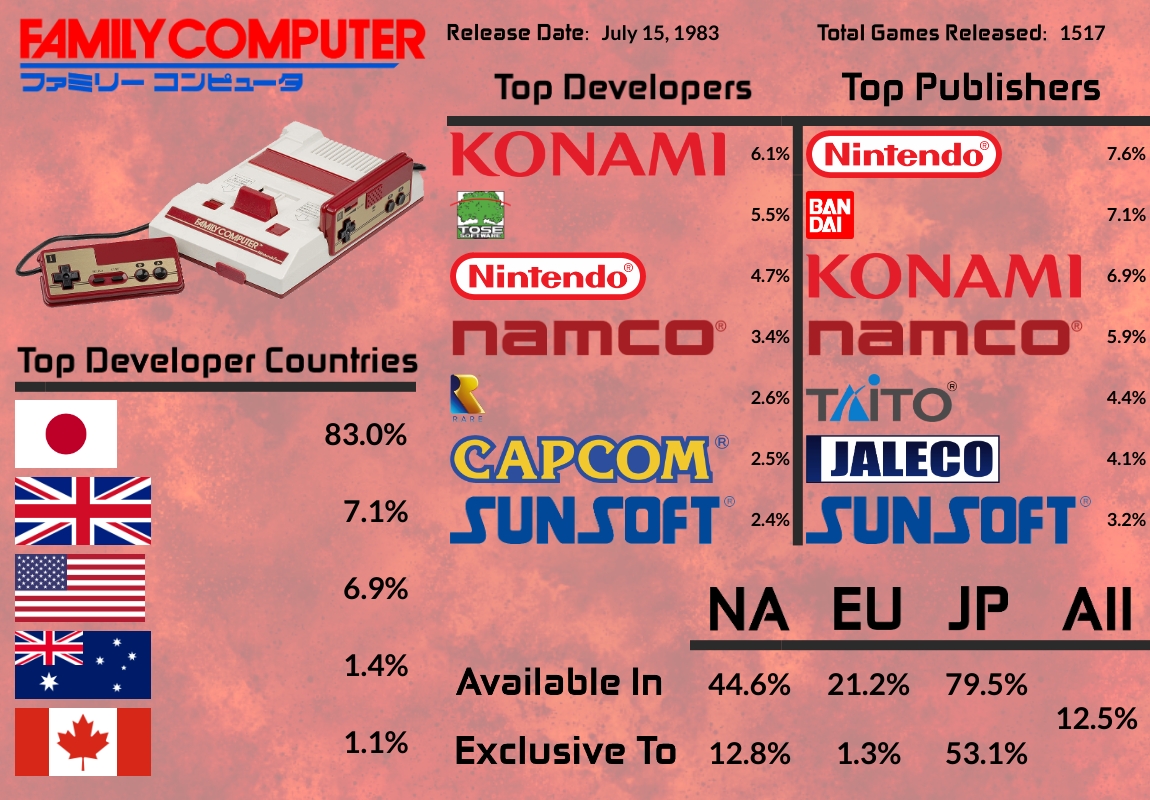
This includes the Famicom, Famicom Disk System, and NES. Wikipedia lists them separately so I had to combine games when they were ported overseas. We can see right away that Japan dominates releases here in the 80s. Eight of the nine companies that developers or published the most games are Japanese, and most of them are still around! Most games were released in Japan and a majority were exclusive.

Nintendo’s next piece of hardware was the Game Boy. Not quite as Japan-dominated as their home console. That 7th developer is Graphic Research. Given its long life and how cheap it was to make games for, you might have expected more than 1053 games.

1751 games, a figure that would not be surpassed until digital distribution. If you’re not familiar with TOSE, here’s a quote from their wikipedia page:
“We’re always behind the scenes,” said Masa Agarida, Vice President of Tose’s U.S. division. “Our policy is not to have a vision. Instead, we follow our customers’ visions. Most of the time we refuse to put our name on the games, not even staff names.”
Many of the games they are now credited with weren’t known at release. There’s a whole wiki dedicated to finding the developers of games. That 7th developer is Telenet Japan. This is the system with the highest percentage of games available in Japan, other than the Virtual Boy.
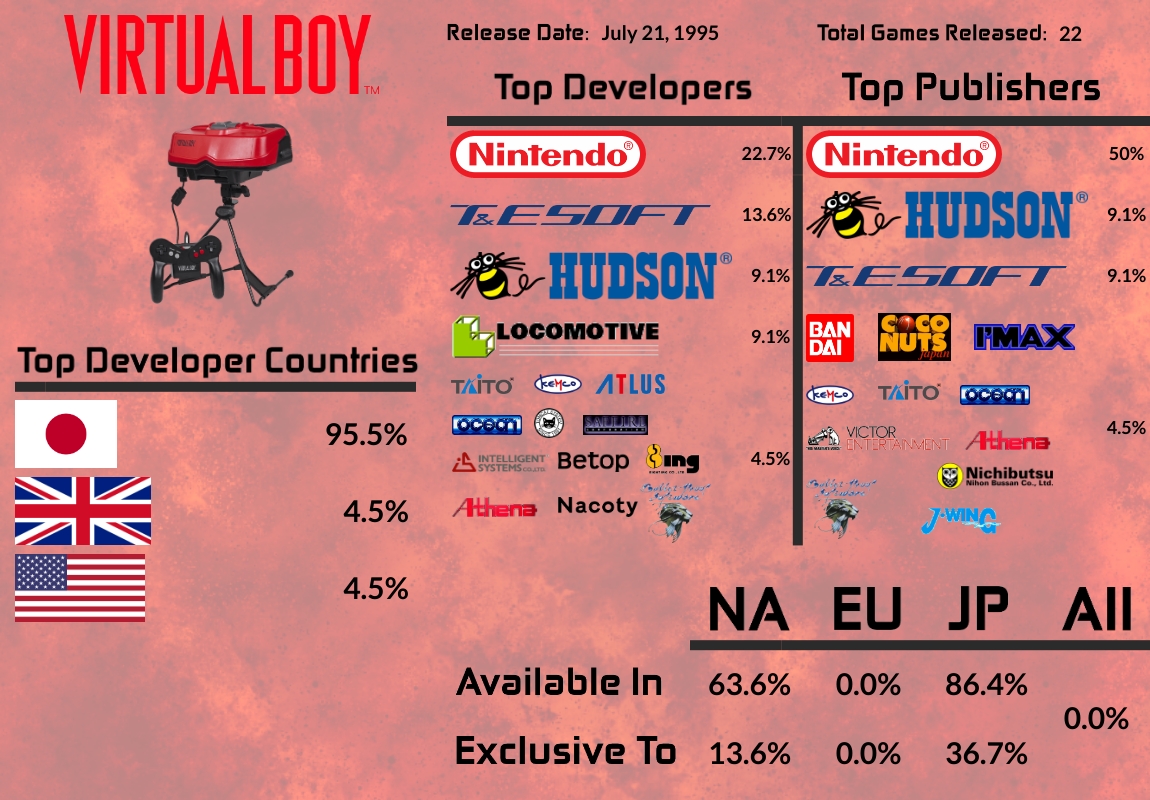
And speaking of the Virtual Boy, here it is, the holder of many distinctions. Two of the developers, Betop and Nacoty were so obscure they have no known logos. Probably the only video game system in the world to boast more than 18% of its library consisting of bowling or Tetris games.
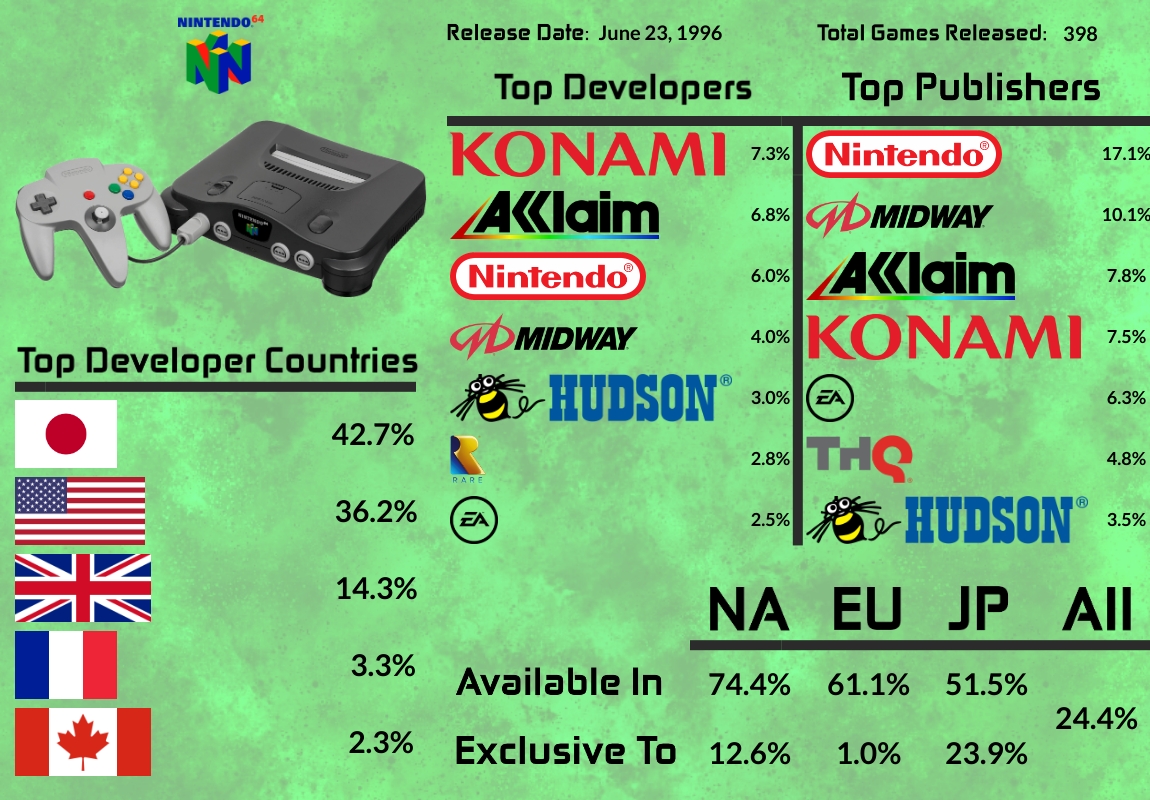
Other than the Virtual Boy, the N64 had a publisher controlling the highest percentage of the catalog. It’s tough when your third party support vanishes so quickly. Also other than the Virtual Boy, the smallest number of games released on a Nintendo system. Few systems are as synonymous with a single developer as the N64 is with Rare, which managed to create the 6th most games for the system, all of them pretty well regarded upon release. We see a big uptick in the percent of games released in North America here, a trend that would continue with consoles. A big drop in the percent of games developed in Japan, too.
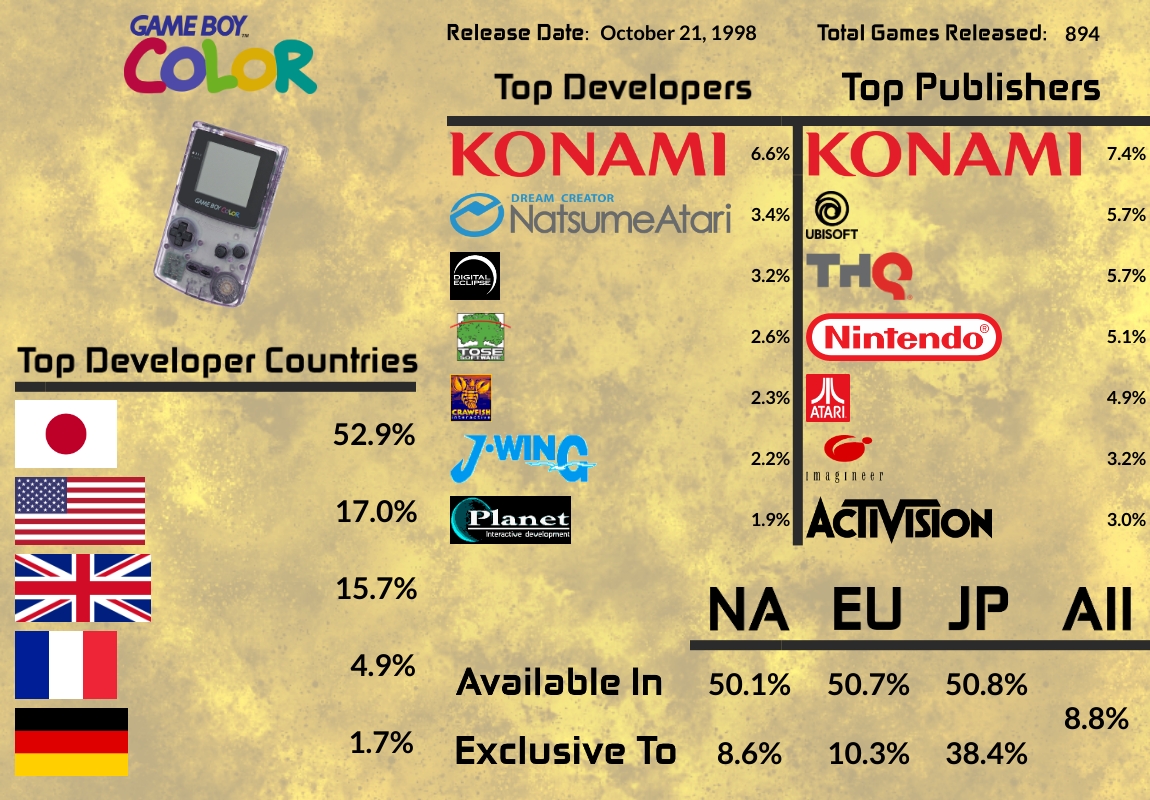
Quite a few games were released on the Game Boy Color, even though its successor was not far away. Many of these were ports of Game Boy titles, however. Nintendo made fewer games for the GBC than any other system except the Virtual Boy. The top developers is odd mix with several companies that we won’t see in the top 7 again. Please note that the Atari in the publishers is Atari, SA, which was at the time known as Infogrames. An incredibly even distribution of games available in each region, yet so few available in all.
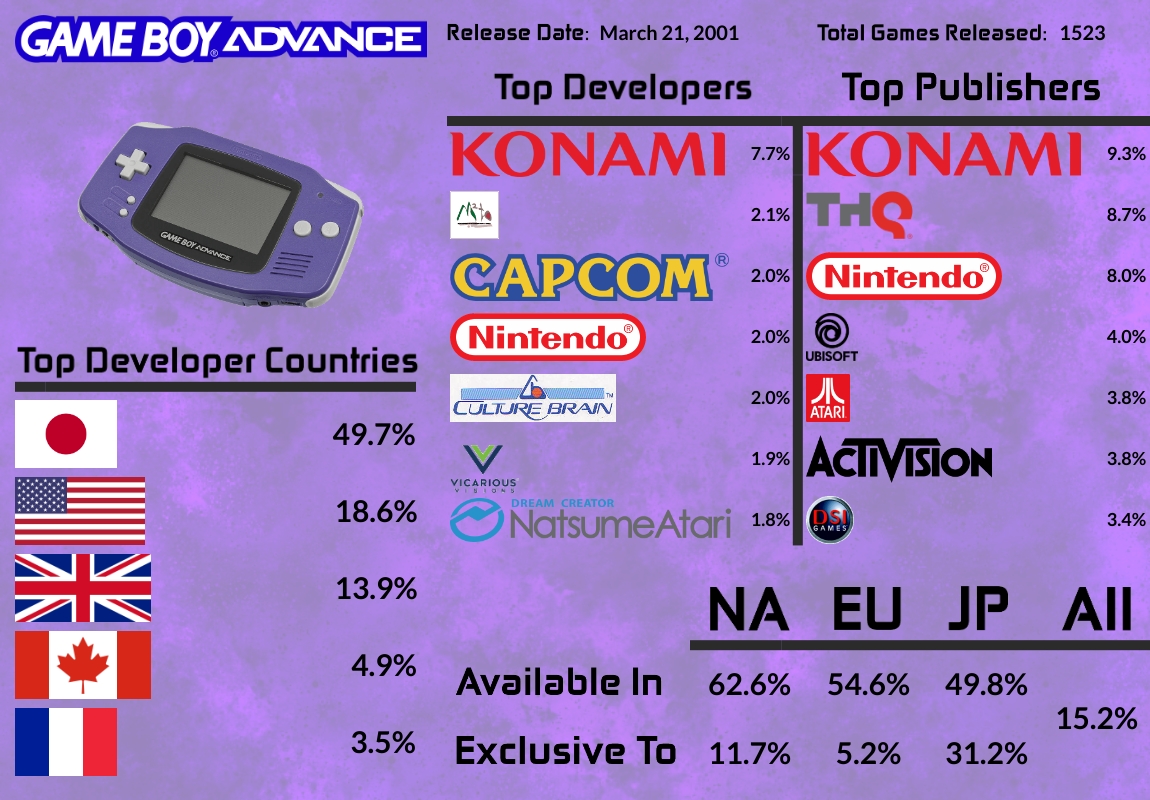
The Game Boy Advance saw a flood of cheap tie in games. This is also towards the end of the era where even many small budget games would get separate versions released on handhelds, made by different developers. It’s very likely that many of those Konami games were not developed by them, but by third parties who did not want to be credited.
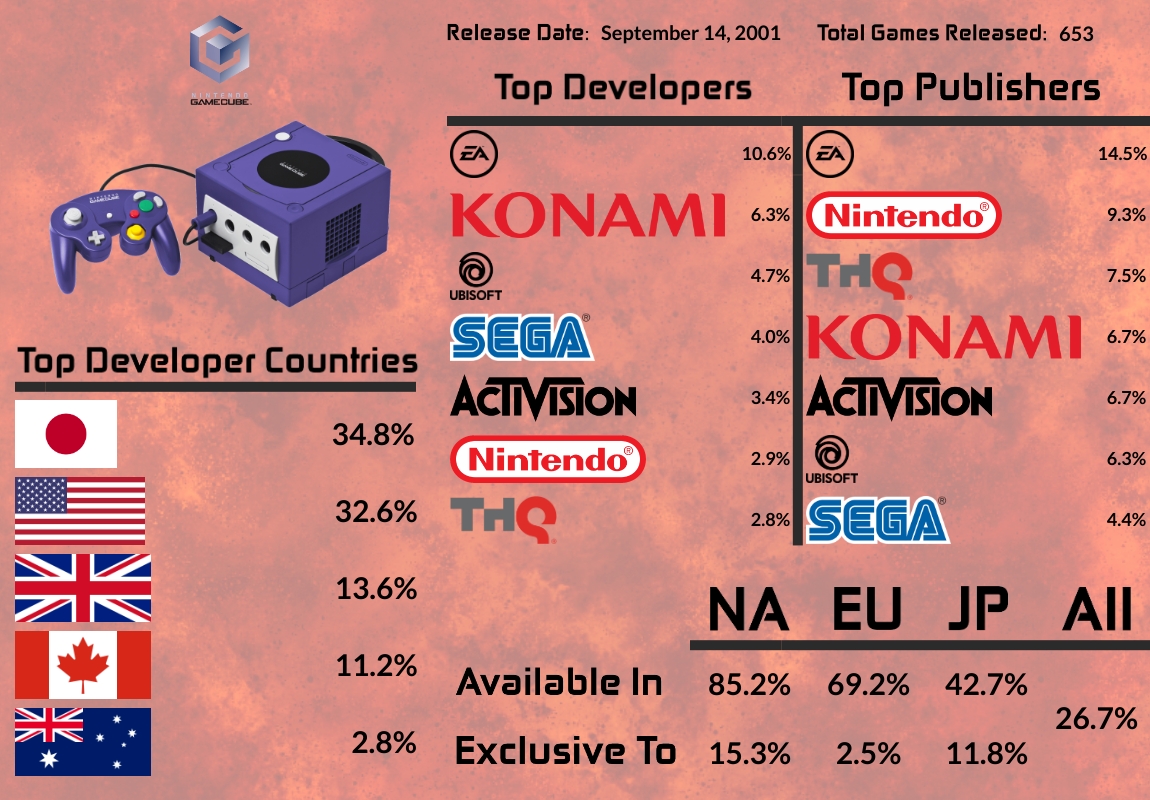
I was pretty shocked by how many Electronic Arts games there were on Gamecube. Several yearly sports titles all hit the Gamecube while Japan largely avoided the console. Over 85% of the library was available in North America, a new high for a region (excluding the Virtual Boy). Despite their last console coming out during the same generation as the Gamecube, Sega managed to make a substantial portion of its library.

Still the Nintendo system with the most titles, the DS was a phenomenon that became the second-best selling video game system. There was a big jump here in the number of countries that developed games. Nintendo developed 65 games for the system, second only to the NES/Famicom’s 72.
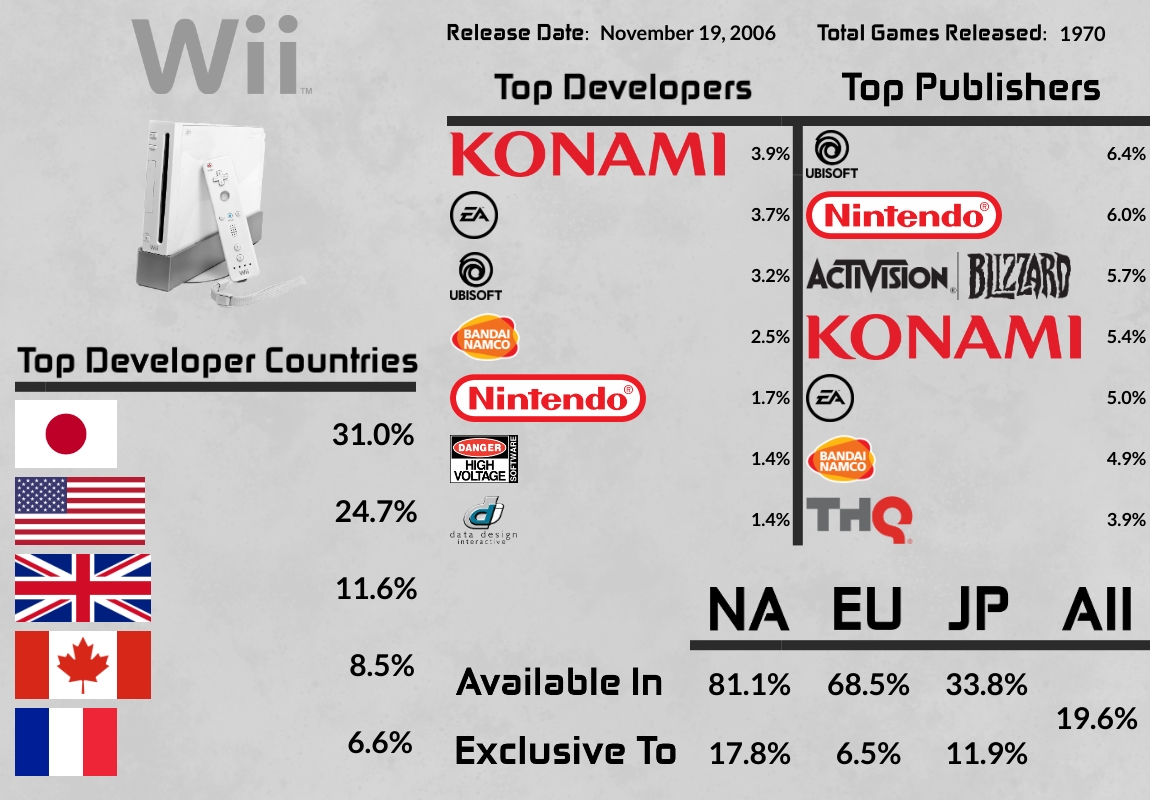
Japan’s lowest share of game development yet, with a lot of North American support. Like the DS, there were a lot of new or new-to-Nintendo developers for the Wii, trying to catch the zeitgeist. Unfortunately, a lot of these titles were shovelware. High Voltage Software and Data Design Interactive don’t come close to this level of output again.
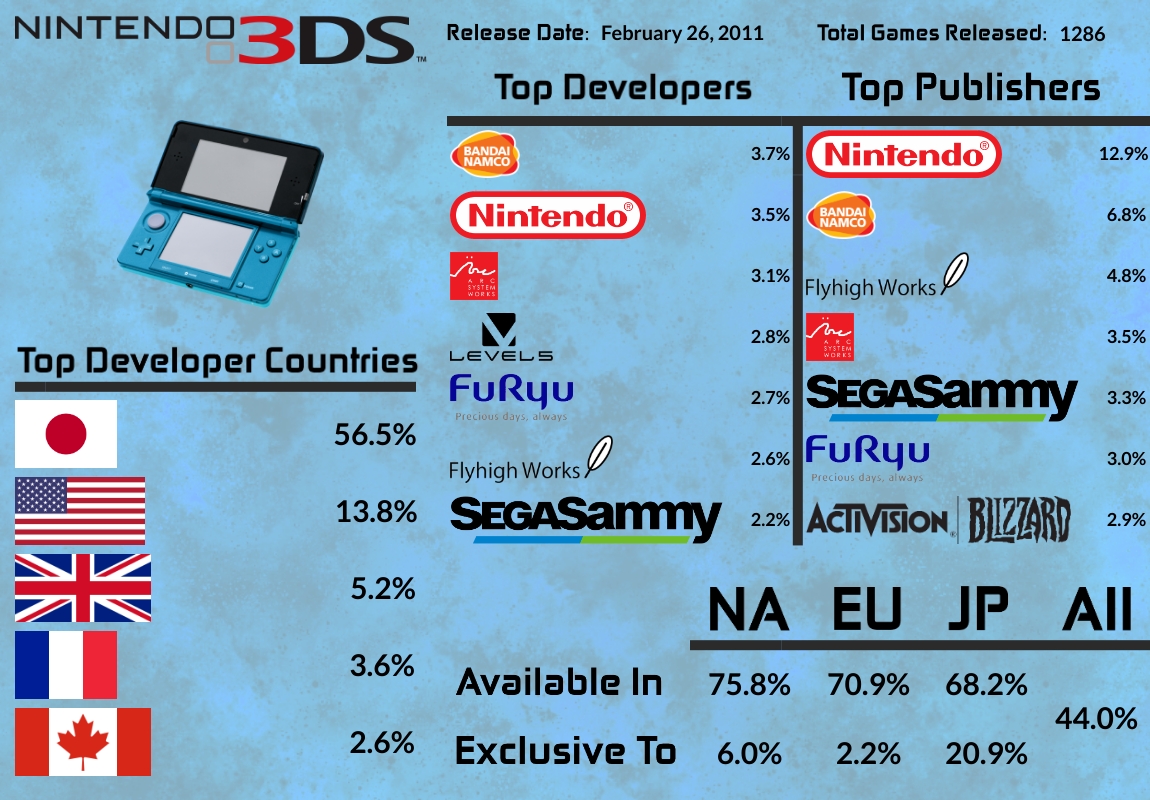
The 3DS bucks the trends and has a lot more Japanese support. One of the things I wanted to look into was the Japanese preference for handhelds and here we can see the difference it makes. Despite this, we see a lot more titles released in all regions than ever before. Four companies make their first appearance in a top 7, all Japanese.
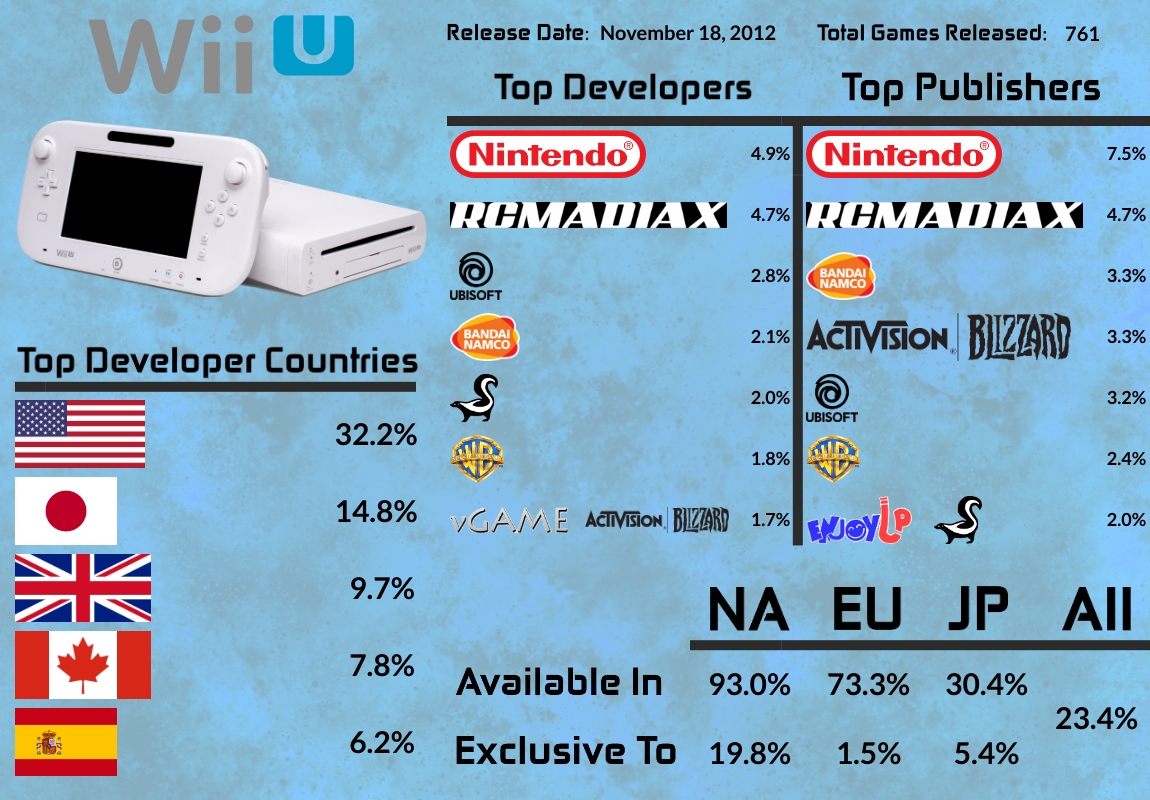
The U.S. takes first place in development for the first and only time with the Wii U. That was largely because of RCMADIAX, who was second in development and publishing output. RCMADIAX was a one man operation that flooded the eShop with cheap, barebones games. He submitted a game for approval on the Switch but was denied and left the video game industry shortly afterward. Skunk Software was also a one-man operation. At 8.41% the Wii U had my highest unknown country of origin. There were quite a few tiny indies that never even had a website and only existed for a couple years.
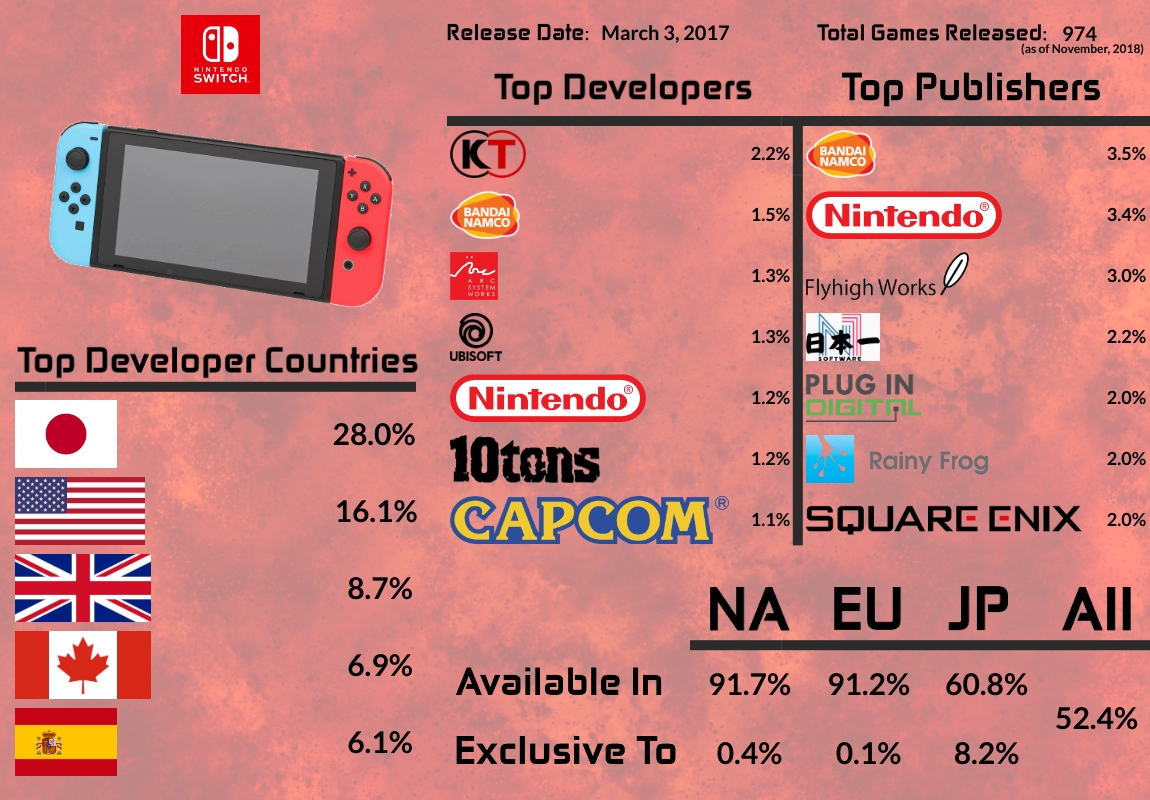
Keep in mind that the Switch has several years left so its library will change, but here is where we stood in November, 2018. At roughly 1000 games every two years, the Switch should eclipse the DS in number of games eventually. You may notice that the top developers and publishers have lower percents than usual. There are tons of new studios that are making Switch games, so it’s very spread out. I had to do the most research for this system because there were so many errors on the wikipedia list. Spain is so high here because there are a lot of Spanish porting studios and lots of those medium to large indie games seem to outsource their Switch ports. We also see an unprecedented surge in all-territory releases, with very few region exclusives. Despite combining their console and handheld teams, Nintendo has thus far developed and published a smaller percent of the Switch library than any of their other systems, largely because of the huge number of titles being released.
Overall Charts
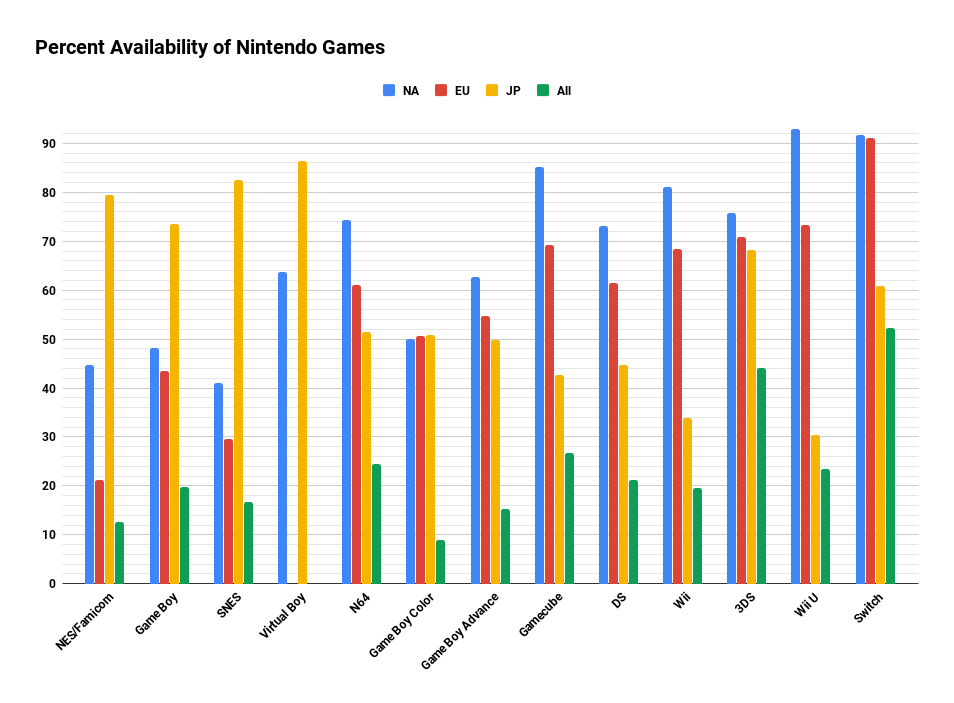
We can see that more games have been coming to more regions over time, although a varying number of games have reached Japan.

While Japan had a large chunk of the exclusives in the early days, that number has fallen greatly. Europe has never had many exclusives.
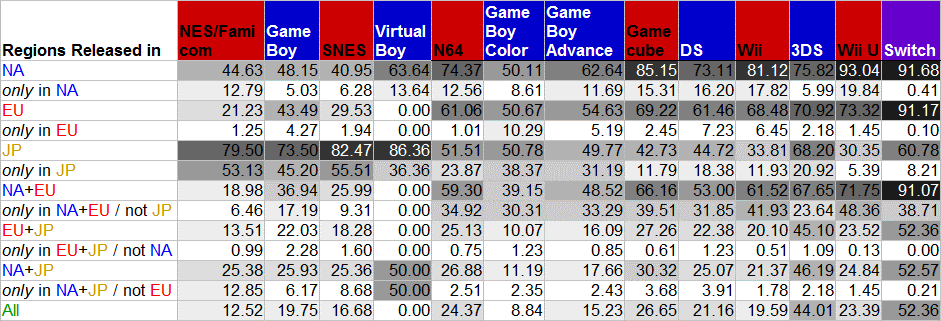
Here’s a chart with all of the available in and exclusive to numbers, but also with combinations of two regions. Japan and Europe exclusives are mostly soccer/football games.
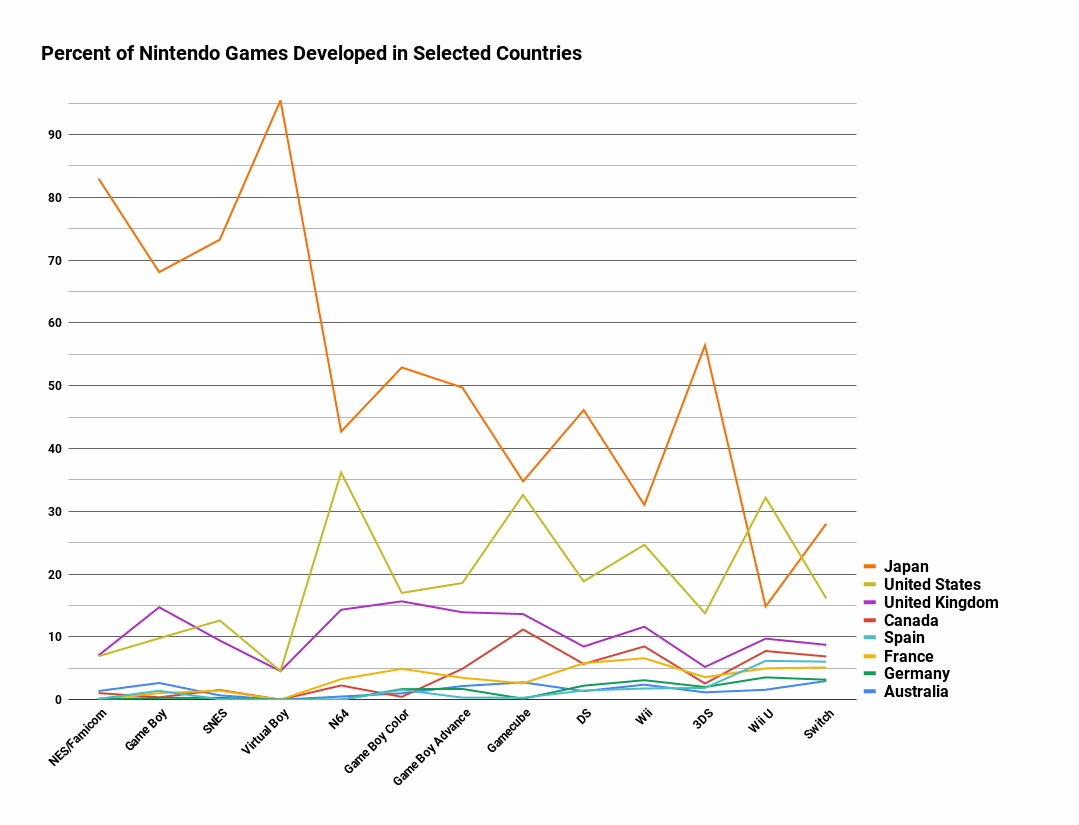
These are the top 8 countries that have developed the most games. Every console has seen Japan’s relative output drop, though they have rallied a bit with every handheld, while it’s mostly the opposite with the United States. Gamecube’s Canada spike was because of EA Vancouver’s sports titles. From the Wii forward Europe and Australia seem to go up and down together.
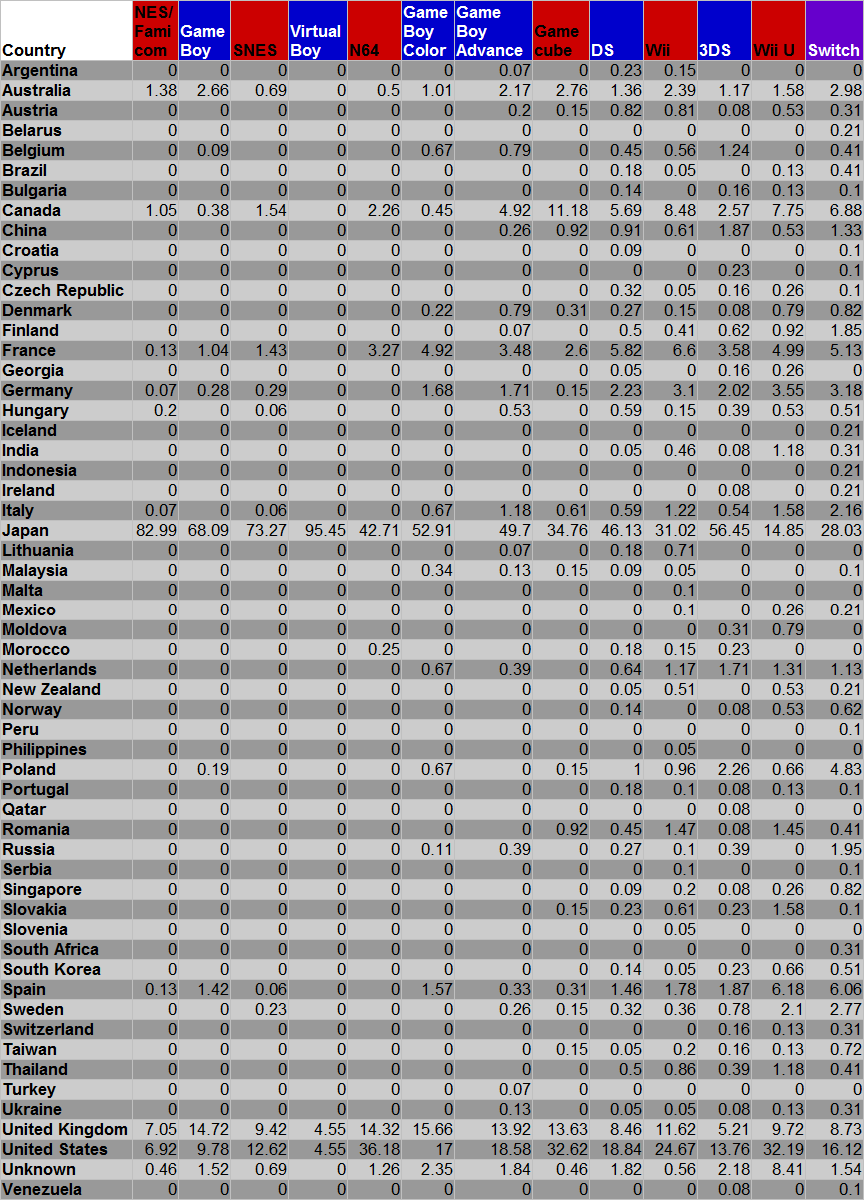

Here’s a chart with every country’s percentage of games and a map of every system put together. As you can see most countries represented only worked on a handful of games, while Japan, the United States, the United Kingdom, and a few Western European countries made the bulk of games. I’d say the Game Boy Advance was the start of more countries getting involved in development.
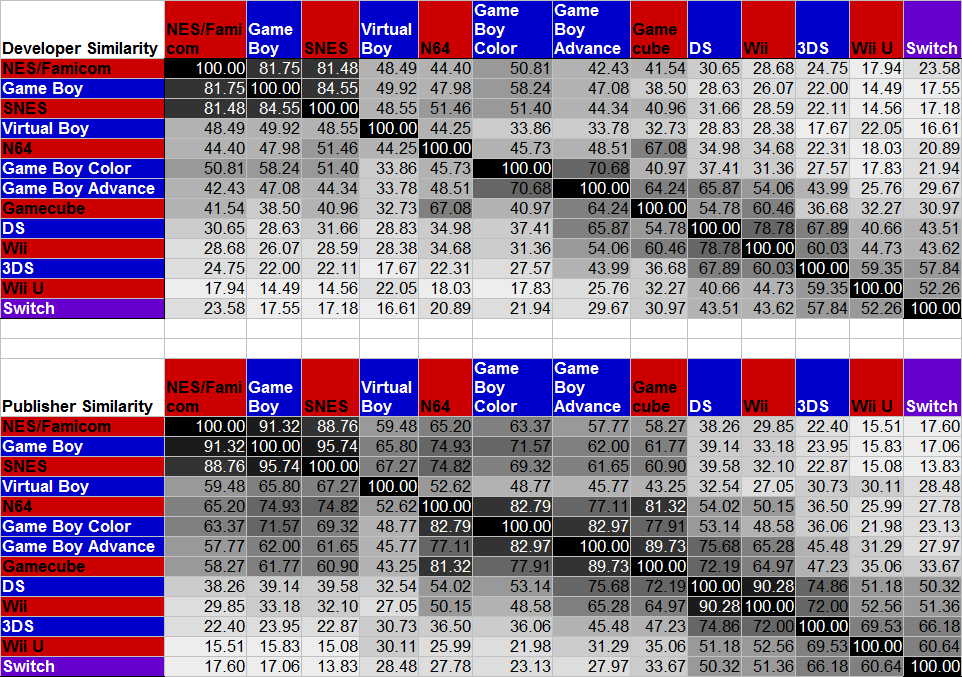
I wanted to measure how similar the group of developers/publishers were from system to system. For instance, maybe a lot of developers were only interested in the handhelds, or maybe publishers would only touch systems that were market leaders. This is a difficult thing to measure, but I gave it a try. Please consider the results as experimental and potentially inaccurate as I am not sure my methods were sufficient. The numbers are not percents, but more like “scores” where the maximum (the exact same developers/publishers in the exact same proportions) is 100. Mostly we see that systems are most similar to systems released close in time to them, which makes sense but is not very enlightening.

I listed the top 7 of each system, but here are the top 25 overall, by number instead of percent this time. Konami’s lead will erode over time, but it will take a few generations with how long it takes to make games nowadays. TOSE is not a well-known name, but it probably worked on a fair number of games they weren’t credited for. Bandai Namco could take both second places if you add their pre-merger companies together. Sunsoft largely left video games by 2001, yet still makes both lists.

In case you wanted an even bigger list, here are the top 100. Please remember that because of the way I combined companies that some of these names will be strange. To hammer home how much cheap junk RCMADIAX pumped out, they hit the top 50 despite being active only during the Wii U.

Here are the developers that released at least one game for at least 10 systems. This time I did combine companies before they merged with their merged company. Lot of absences for the Virtual Boy, of course. Intelligent Systems will make its Switch debut very soon with Fire Emblem: Three Houses and become the only second/third party to support every Nintendo system. Kemco had a rare Virtual Boy title, but skipped the DS of all things. Konami only released Virtual Console titles for the Wii U, yet had a launch title ready for the Switch. Square had a bit of a falling out with Nintendo over the move of Final Fantasy 7 to the Playstation, which kept them away for a time, but they eventually made up.

And here are the publishers that have supported at least 10 systems. Square Enix let Nintendo publish Final Fantasy Crystal Chronicles, which keeps them from the “everything but Virtual Boy” club. Ubisoft, Electronic Arts, and Take-Two weren’t always huge publishers, but they have been releasing games on Nintendo systems for a long time.

Have you ever wondered how popular it was to put “64” in the title of N64 games? More than a fifth of them did. Seven is the least common digit in titles. Almost every game title is made up of at least two words (this is a count of titles in which a text string occurs, not a total count).

Here’s the same data grouped into themes and maybe a bit easier to read.

And finally, some miscellaneous data, like how many developers/publishers only released one game on a system, and how many games were developed by more than studio, published by more than one company, and made in more than one country. Here we see that collaborations between studios, including studios in different countries has increased over time.
Other Facts I Came Across
-
From Ubisoft Montreal’s wikipedia page: “The studio as of 2017 employs more than 3,500 staff, making it one of the largest game development studios in the world.”
-
I recorded numbers for Hong Kong separate from China, but didn’t end up using them. There were 33 games developed in Hong Kong, and 50 elsewhere in China.
-
Similarly for the UK: England 1474, Scotland 74, Wales 18, Northern Ireland 1.
-
Just Dance 2014 for the Wii and Yo-kai Watch Dance: Just Dance Special Version for Wii U both had 7 development teams listed, although these vary a bit by source.
-
The shortest game title was X for Game Boy.
-
The longest game title, which I cannot confirm is accurate, is a 3 in 1 game collection: Kunio-kun Nekketsu Collection 3 Downtown Special: Kunio-kun no Jidaigeki da yo – Zenin Shūgō! Ike Ike! Nekketsu Hockey-bu: Subete Koronde Dairantō.
-
The total developer count was 2299 when combining studios owned by companies. However, the way I structured things included these subsidiary studios separately. There were 2547 developers including them (plus a few tiny ones that I lumped together).
-
Atlus was owned by Takara (7 games), Sega Sammy (12 games), Index (17 games), and was independent (46 games) which would have been good enough for 22nd most prolific developer if combined.
-
I have 14 THQ-owned, 15 Take-Two-owned, 23 Electronic Arts-owned, and 24 Ubisoft-owned developers recorded.
-
I noticed some recurring themes in developer names. The following are the number of studios with a given string in their name. 21: 3, Infinite: 5, Planet: 5, Silicon: 6, Ninja: 8, Black: 12, Dream: 14, Pixel: 20, Star: 21.
Sources
-
Wikipedia’s lists of games was my starting point, although I had to make a lot of corrections and additions. I also visited hundreds of developer, publisher, and individual game pages.
-
Moby Games has lots of great information, including port teams, developer histories, and official website links.
-
The Giant Bomb wiki has a lot of more obscure titles and some info I couldn’t find anywhere else.
-
GameFAQs has pages for almost every obscure Japanese game.
-
RF Generation was useful for a list of eShop titles.
-
Nintendo has pages for most games released on their last few platforms.
-
Dolphin wiki for some info about Gamecube and Wii games.
-
Nintendo life for some Wii U eShop game information.
-
Youtube videos showing the splash screens as games start up.
![]()
![]()
